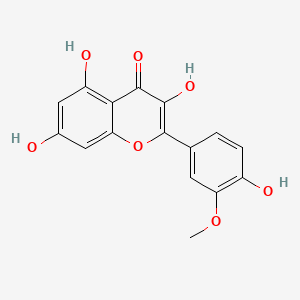Isorhamnetin
Isorhamnetin is a lipid of Polyketides (PK) class. Isorhamnetin is associated with abnormalities such as Facial Hemiatrophy, Colitis, endothelial dysfunction, Morphologically altered structure and Diabetes. The involved functions are known as enzyme activity, Methylation, Anabolism, Binding (Molecular Function) and Vmax. Isorhamnetin often locates in Body tissue, Cytoplasmic, Mucous Membrane, Cytoplasm and Human tissue. The associated genes with Isorhamnetin are CSK gene, RPS6KA3 gene, Mitogen-activated protein, NCF1 gene and Chromatin. The related lipids are Fatty Acids, Phosphatidylserines and Palmitates. The related experimental models are Mouse Model, Xenograft Model and Streptozotocin Diabetes.
References related to functions published in Others
| PMID | Journal | Published Date | Author | Title |
|---|---|---|---|---|
| 9688981 | Am. J. Physiol. | 1998 | Morand C et al. | Plasma metabolites of quercetin and their antioxidant properties. |
| 23824743 | Cancer Res. | 2013 | Saud SM et al. | Chemopreventive activity of plant flavonoid isorhamnetin in colorectal cancer is mediated by oncogenic Src and β-catenin. |
| 20693356 | Plant Cell | 2010 | Ono E et al. | Functional differentiation of the glycosyltransferases that contribute to the chemical diversity of bioactive flavonol glycosides in grapevines (Vitis vinifera). |
| 20484173 | Cancer Prev Res (Phila) | 2010 | Bobe G et al. | Interleukin-6 as a potential indicator for prevention of high-risk adenoma recurrence by dietary flavonols in the polyp prevention trial. |
| 19487249 | Drug Metab. Dispos. | 2009 | Lau AJ and Chang TK | Inhibition of human CYP2B6-catalyzed bupropion hydroxylation by Ginkgo biloba extract: effect of terpene trilactones and flavonols. |
| 15159318 | Cancer Epidemiol. Biomarkers Prev. | 2004 | Brevik A et al. | Urinary excretion of flavonoids reflects even small changes in the dietary intake of fruits and vegetables. |
| 24913217 | J. Nutr. Biochem. | 2014 | Dou W et al. | Plant flavonol isorhamnetin attenuates chemically induced inflammatory bowel disease via a PXR-dependent pathway. |
